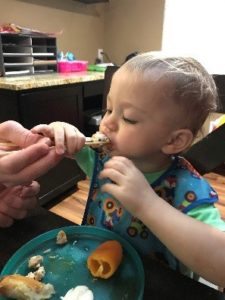Raising My Kids To Be Adventurous Eaters: Part 1
“Hey Lauren, Mommy is ordering takeout tonight, what kind do you want?”
“The one with the chicken and salad and the yummy balsamic dip.”
Yes, this is a conversation that occurs every time we order takeout. My five-year-old kid doesn’t want pizza or mac and cheese (although that’s usually the request from my two-year-old), she wants a chicken plate with salad from Modern Market. At one point, she’d tell you her favorite food was “the peppers with the chicken inside and all the flavors,” (also known as buffalo chicken stuffed peppers) and I’ve seen her polish off an adult-sized portion of Szechuan pork with zucchini noodles.
I regularly get comments or reactions about the kinds of foods my kids eat, and that’s quickly followed by questions about how I did that.
I’m hardly any kind of parenting expert, and I’m making zero promises that because something worked for my kids that it might work for yours (I’ve got two kids, I know better than to think that). Maybe something I did contributed to that, maybe I got lucky. Maybe a little of both. All I know is that I love food – I love cooking food, eating food, sharing food, and experiencing new foods. And I wanted to do everything I could to instill that in my kids as well.
Introducing food when they were babies
I learned about Baby Led Weaning (also called Baby Led Feeding) well before I had my own kids – I had foodie friends who had done it with their kids and the ideas definitely intrigued me. I recommend checking out the website or getting the book from the library for more details, but here’s the general gist:
- Things like baby food and purees teach babies to swallow before they learn to chew when it should be the opposite – babies need to learn to chew food, then swallow it.
- Large, easy to grab foods that babies can hold themselves gnaw/chew on reinforces this idea, and purees are discouraged (my kids never had baby food, at all – closest thing was some applesauce or yogurt).
- Start with things that are difficult to chew off pieces, gradually work your way towards more chewable foods.
- Wait a little longer to introduce solids (around six months), so babies have enough coordination to sit up and chew on solid foods.
- From the beginning, include a variety of foods at the same time, giving babies choices about what they want to eat.
 So when my kids each hit six months, we were off to the races – we started with big slices of bell pepper, whole strawberries, cucumber spears, roasted asparagus spears, mango slices, and eventually moved to things like large chunks of banana, toast sticks, graham crackers, etc. The bell pepper strips and mango slices were often Lauren’s favorite – she’d gnaw on them and suck all the juice out leaving only the skin of the pepper and the meat of the mango.
So when my kids each hit six months, we were off to the races – we started with big slices of bell pepper, whole strawberries, cucumber spears, roasted asparagus spears, mango slices, and eventually moved to things like large chunks of banana, toast sticks, graham crackers, etc. The bell pepper strips and mango slices were often Lauren’s favorite – she’d gnaw on them and suck all the juice out leaving only the skin of the pepper and the meat of the mango.
The kids always sat at the dinner table with us, even at the beginning when they were just gnawing on cucumber spears or a piece of toast. We wanted them to see us  eating, to be interested in what we were eating. By month seven or eight they always started pointing to things on our plates, as if they were saying “Hey, I know you’re eating something I’m not, I want some!” So we started integrating more and more of our own meals onto their plates as well. Anytime we introduced a new food, we also include one to two foods that were more familiar – a cheese stick and a strawberry or two, in addition to some spaghetti and a meatball, etc.
eating, to be interested in what we were eating. By month seven or eight they always started pointing to things on our plates, as if they were saying “Hey, I know you’re eating something I’m not, I want some!” So we started integrating more and more of our own meals onto their plates as well. Anytime we introduced a new food, we also include one to two foods that were more familiar – a cheese stick and a strawberry or two, in addition to some spaghetti and a meatball, etc.
As we moved through foods, we strived to introduce a variety of foods. We gave them two to three things at a time, and aimed for them all to be different colors (who wants an entire tray of brown food, right?), different textures (some crunchy, some chewy, some soft), and different flavors (salty, sweet, savory, etc.). And most importantly, we never stopped  them if they wanted to try something – even if it was the lemon out of my water while at a restaurant, or a spicy tuna roll during sushi takeout night, or eating ribs straight off the bone.
them if they wanted to try something – even if it was the lemon out of my water while at a restaurant, or a spicy tuna roll during sushi takeout night, or eating ribs straight off the bone.

But let’s be honest – feeding them before they can talk (or more importantly, talk back) is pretty easy. If they don’t like something, they might make a face or throw it off their tray, but how do these ideas hold up during the toddler and preschool years?
Come back in a couple weeks and I’ll share how we tackle dinnertime – what goes on the plate, what doesn’t, and after-dinner treats.